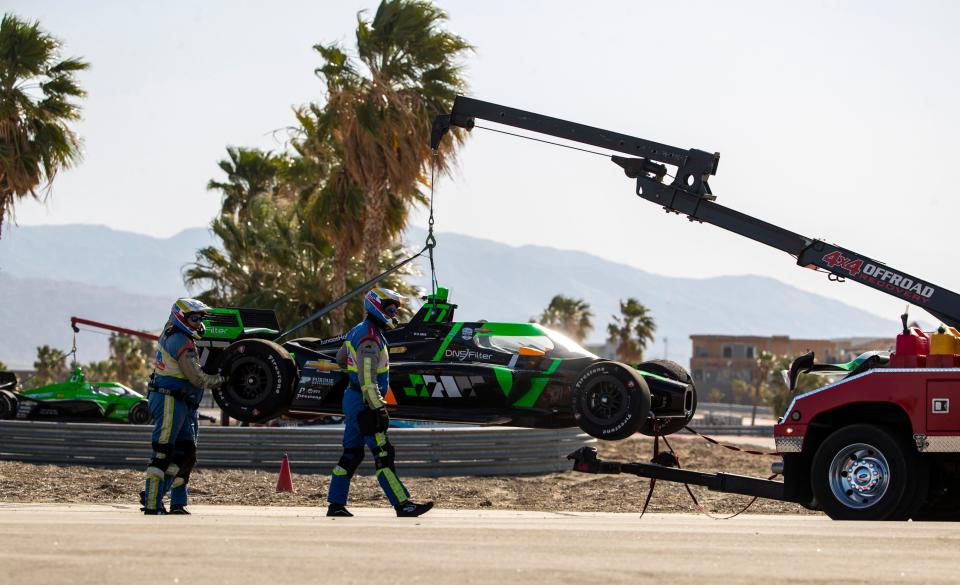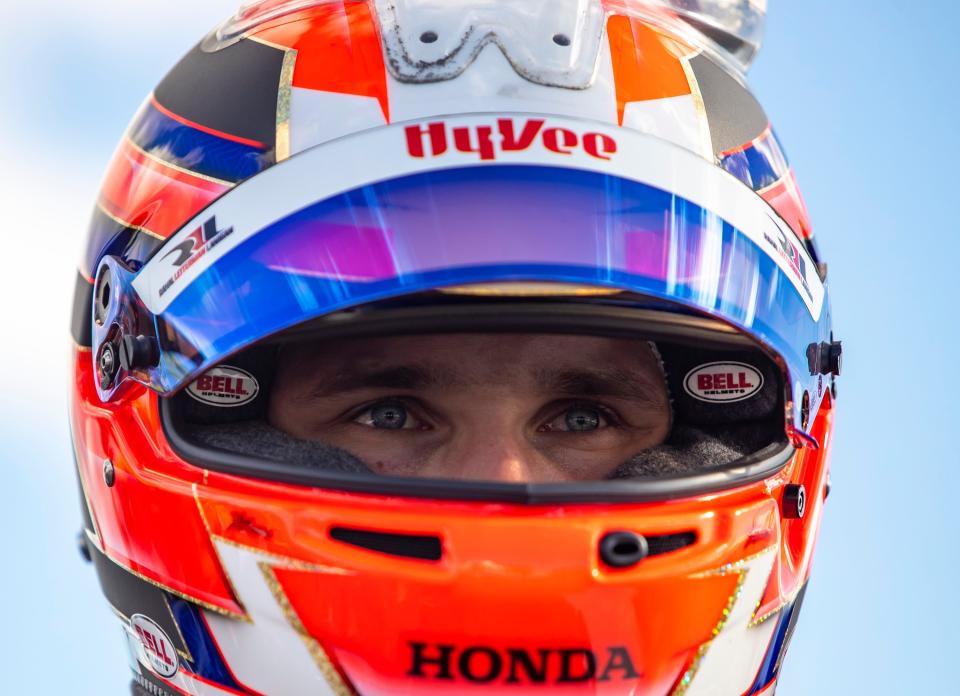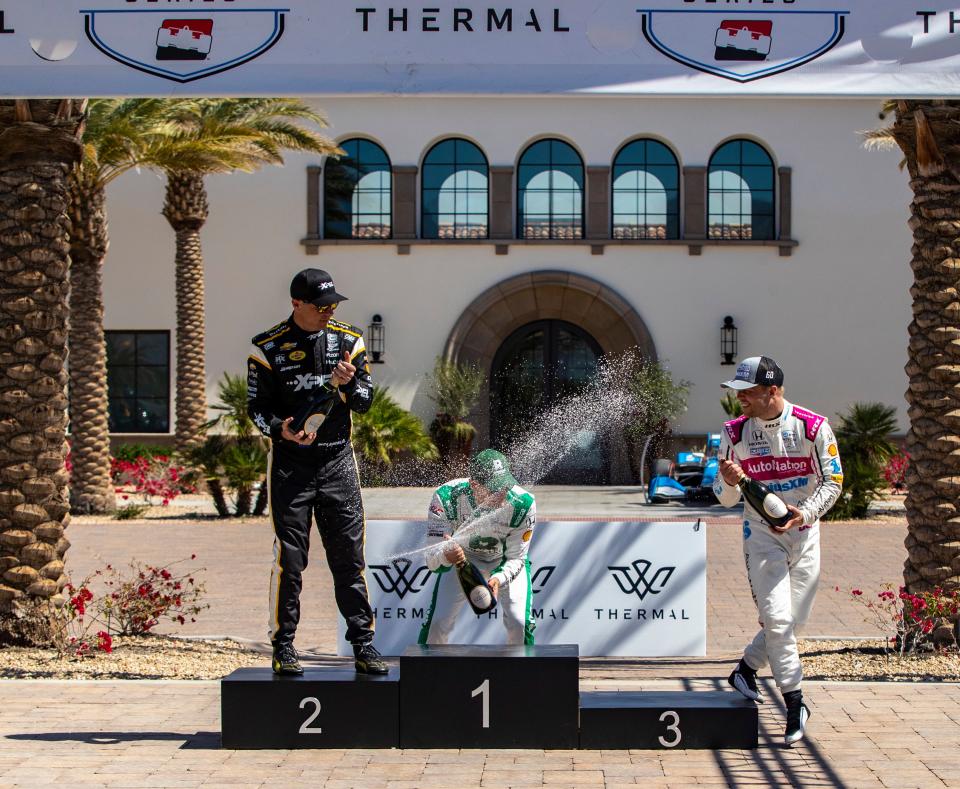Drivers praised IndyCar's ingenuity with $1 Million Challenge. One called for 2025 boycott
THERMAL, Calif. – After the final checkered flag had fallen to close Alex Palou’s dominant weekend at The Thermal Club’s $1 Million Challenge, IndyCar drivers and team owners remained mixed on the legitimacy and success of a lengthy test and race weekend that handed out a few sizable checks but paid no points.
Predictably, opinions were largely left split between those who achieved major paydays -- $500,000 for Palou and CGR, $350,000 for runner-up Scott McLaughlin and Team Penske and $250,000 for Felix Rosenqvist and Meyer Shank Racing – and those shouldered with hefty repair bills and zero points for their troubles.
Opinions of a dozen paddock members IndyStar spoke with post-race on the track, format and IndyCar's first non-points race since 2008 ranged from calling it a largely successful experiment, to something drivers and teams may consider boycotting if it’s brought back in 2025.

“For us, it didn’t go too well. I would’ve just as soon not participated in the race portion, but the testing was beneficial,” driver-owner Ed Carpenter told IndyStar. “We’ll see what the verdict is from the actual (TV) viewers on if it was impactful or not.
“Ideally, if it’s going to be a race, it needs to be an actual race. Points, all the cars, full distance, otherwise it feels a little gimmicky.”
But aren’t occasional gimmicks – Formula 1 sprint races, the NBA’s All-Star skills challenge and NASCAR’s All-Star race and revamped Clash, to name a few – precisely what several sports are finding helps attract new viewers and freshen up some, at times, boring competition?
“Then I think, at minimum, it needs to be more money for those who make the final round,” Carpenter continued. “And probably a bigger pot altogether. Look at (6th-place Linus Lundqvist and CGR); they got the same reward as us, and we got crashed out on Lap 1 of the heat.”
How he did it: Ganassi’s Alex Palou wins $500,000 in IndyCar’s $1 Million Challenge

An exhibition that began with carnage
The pair of $23,000 paydays ECR’s No. 20 and 21 Chevys took home will likely take only a decent bite out of the crash bill related to Rinus VeeKay’s machine being pile-drived by a skidding Romain Grosjean seconds after the green flag in Heat 1 – marking the biggest ‘wow’ moment in the 38 laps turned Sunday morning. Perhaps just as surprising was that six-time series champ Scott Dixon was the instigator, having misjudged how Grosjean would play the jam-packed entry into Turn 1 while the whole 14-car heat field had push-to-pass at their disposal.
Though the theory there would be no passing on the Club’s 3.067-mile permanent road course was disproven throughout the day, Grosjean wasn’t at all surprised the first of 646 turns on the day led to chaos. It did, though, only inflame his frustrations that racing action airing on an NBC network TV window didn’t have any points on the line.
“Who’s going to pay for the damage?” he questioned, emphatically. “We didn’t do anything wrong, and we got absolutely destroyed.
“We come here with no points on the line and do nothing wrong, and the car is completely smashed. I don’t know, but that’s not what I signed up for.”
By the numbers: Here's how much top finishers will take away from IndyCar's $1 Million Challenge

'Not eventful, not exciting'
With the days of VeeKay and Grosjean over in a blink, and Dixon’s all-but ended after a drive-thru penalty for avoidable contact, the highlights of the rest of IndyCar’s exhibition included mild-mannered highlight moments centered around the three Arrow McLaren teammates dueling for a single advancing spot in Heat 2, Alexander Rossi’s wheel-banging with Josef Newgarden in the main event and Colton Herta’s launch from the back-half of the grid over the closing 10 laps with strategic – but legal – gaming of the system in preserving his tires by running the first half of the final just fast enough to simply not get lapped.
Herta ran 12 seconds slower than the leaders on Lap 1 of 10 before the main event’s halftime stoppage, a strategy that had been whispered about for days. But it fit right within the rules, which called for a 10-lap stint, a halftime where teams could refuel but not change tires and then a closing 10-lap sprint to the finish. With fuel not an issue, tire life would be a prized possession, and with no difference between trundling around in 12th or staying ahead of the leader, the call to best-position Herta for a top-half finish was obvious.
Whether it made for entertaining television – as basically the entire back-half of the main event’s 12 cars followed suit – was an entirely different story. The term “snooze fest,” first used by Andretti driver Marcus Ericsson, among those IndyStar spoke with post-race, proved popular.
“That was not eventful. It was not exciting,” Pato O’Ward told IndyStar, as he sat among his teammates and Arrow McLaren sporting director Tony Kanaan, as the group pow-wowed about the event’s questionable success. “Can you imagine Turn 1 with 27 cars? That would’ve been awesome, but Heat 1’s start was the most eventful part of it all.”
Alexander Rossi, the team’s sole driver who qualified for the final, described the event’s first half as nothing but “parade laps.”
“You’ve got to allow pitstops (in the final). That’s the only way to change it. Otherwise, if we do this again, it’s going to be the exact same thing, and there’s no point,” Rossi continued, pointing toward the finale’s finale 10 laps as a source of lighthearted, low-risk run as he dueled with Josef Newgarden – “It’s funny when people hurt themselves for the sake of hurting you” – and being witness to Herta’s roll-of-the-dice that left him 4th after starting 12th. “It was pretty anti-climactic from our point-of-view.
“Honestly, I would like it to be a real event, because I think this track is pretty awesome. Tire deg exists, and if you add an alternate to that, plus pitstops, and then strategy on top, it would be one of our classic tire deg races. I just would love to see a real event here, because I think it’s a beautiful place, an amazing one that looks good on TV.”

'I don't think we're showing (back) up'
For some, though, the lack of meaningful passes was the least of their frustrations.
Post-race, Christian Lundgaard and Rahal Letterman Lanigan Racing officials were enraged at what they deemed a lack of consistency in race control’s view on what teams could change or repair without being disqualified. While running on the outside of VeeKay while rolling through Turn 1 on Lap 1 of Heat 1, the left side of Lundgaard’s No. 45 Honda weathered a heavy blow from VeeKay’s No. 21 Chevy, Lundgaard managed to trundle on and hang on to a top-6 spot to advance. When he pulled back into pitlane, though, his crew noticed the sizable gash in his left sidepod. Aware it would likely lead to a trip to the back of the finale’s field because the fix likely wouldn’t be a true emergency, RLL officials were puzzled when they were told swapping out the body work was a stretch too far.
Do so, and their day would be done. Instead, they grabbed a roll of BearBond repair tape – essentially duct tape on steroids – and applied the largest Band-aid they could and accepted dropping back three spots from 8th to 11th.
So imagine their surprise when they learned Andretti Global was permitted to swap out Colton Herta’s entire front wing after the No. 26 Honda’s Lap 1 contact with Dixon that sparked the ensuing pileup. Race control ruled Herta would have to start the finale from the back – which he already was to begin with.
To make matters worse, RLL asked during the break in the main to cut off fraying pieces of tape from Lundgaard’s car that was flapping in the wind. Race control deemed even that emergency service, losing him a couple spots before the race’s final restart.
Bobby Rahal was beside himself post-race, telling IndyStar: “I don’t know who makes these decisions, but it’s idiotic.”
Added Lundgaard: “If we’re voluntarily invited back here next year, I don’t think we’re showing up.”
Wait, you mean your whole team?
“Yup. The way this has gone, just, what is there to gain, when we’re supposed to race, and we have a bunch of damage, and we can’t even fix it?”
Insider: Why IndyCar needs success with $1 Million Challenge

Weighing the benefits of an imperfect event
As he begrudgingly sat on the sidelines this weekend, no longer with a full-time ride and instead serving as one of IndyCar’s social media influencers for the weekend, Conor Daly had, perhaps, a more holistic view. Though the current Indy 500-only driver for Dreyer and Reinbold is largely unafraid to share his views on the series’ shortcomings from time-to-time, Daly’s weekend-long position – even in spite of the long spurts of inaction that dominated Palou’s runaway win – boiled down to this:
“At least we’re racing.”
Faced with the unexpected loss of the annual visit to Texas Motor Speedway in the spring, creating a six-week gap between Race No. 1 (St. Pete) and Race 2 (Long Beach), IndyCar took that network TV window from NBC and made use of it. With a list of viable venues, frustratingly at 1, Penske Entertainment executives took up The Thermal Club’s invitation for a return trip that, even this weekend, was still being molded into its final product.
What came of it, if nothing else according to Daly, should’ve quenched the fanbase’s thirst until the calendar begins rolling in earnest.
“I just don’t know what our fans are looking for. No matter what race it is, you’re going to look at what strategy you can play to win as a team. We don’t show up to finish 4th,” said Daly in response to the complaints of the main event’s first half that proved to be a glorified warmup. “It played out like it did, but for me as a race fan, I’m fine, because I know we have the second half.
“No one’s ever going to be fully happy, and some people are going to be angry with everything, but you got free racing to watch on Sunday, and if you’re going to sit there and say, ‘I don’t want to watch it’, well then, that just means you’re not a race fan.”
Palou joked Saturday evening, after he secured his heat race pole, that he’d be strapping on a bumper to help him withstand his hard-charging peers. He admitted, like the rest of the podium, that IndyCar’s $1 Million Challenge needs some tinkering to reach its best form. For one, he – like others – turned their nose up at holding a non-points event outside the offseason. In its simplest form, he added, the format – 10-lap heat races with half the field, followed by a 20-lap main event with a break in between – left much to be desired, and in ways hindered the racing spectacle IndyCar so passionately boasts of.
Admittedly reflecting on the weekend with their glasses half-full, having finished on the podium, the trio of podium finishers largely agreed that IndyCar’s weekend-long experiment has a foundation Penske Entertainment officials can polish and mold into an event that even better combine’s the looseness of an exhibition with the high-energy action of a traditional IndyCar weekend.
“I think it all comes down to the support that we got from The Club,” McLaughlin said. “I think Thermal (members) have just put their backs behind IndyCar for this and created an awesome event. The opportunity for all the teams to come out here and earn money, but also to put on a show and even have a test for two days, you’ve got to give props to Thermal.
“This was a good opportunity to try completely different things.”
And if it’s possible – admitting the immediate oddity of the venue’s inability to host more than a few thousand guests – perhaps IndyCar could step even further outside its comfort zone and take full advantage of what Rosenqvist called “the most challenging track we’ve been to in a while” and run a full-on regular season event.
“This was an experiment, right? I think today we proved we can race here just like any other track,” he said. “I think an actual points round would be really cool.
“IndyCar has been very open with this event, and they told us to keep an open mind going in. I thought it was great – so much fun to be out there doing something different than we do every weekend.”
This article originally appeared on Indianapolis Star: IndyCar drivers, owners mixed on success of $1 Million Challenge

